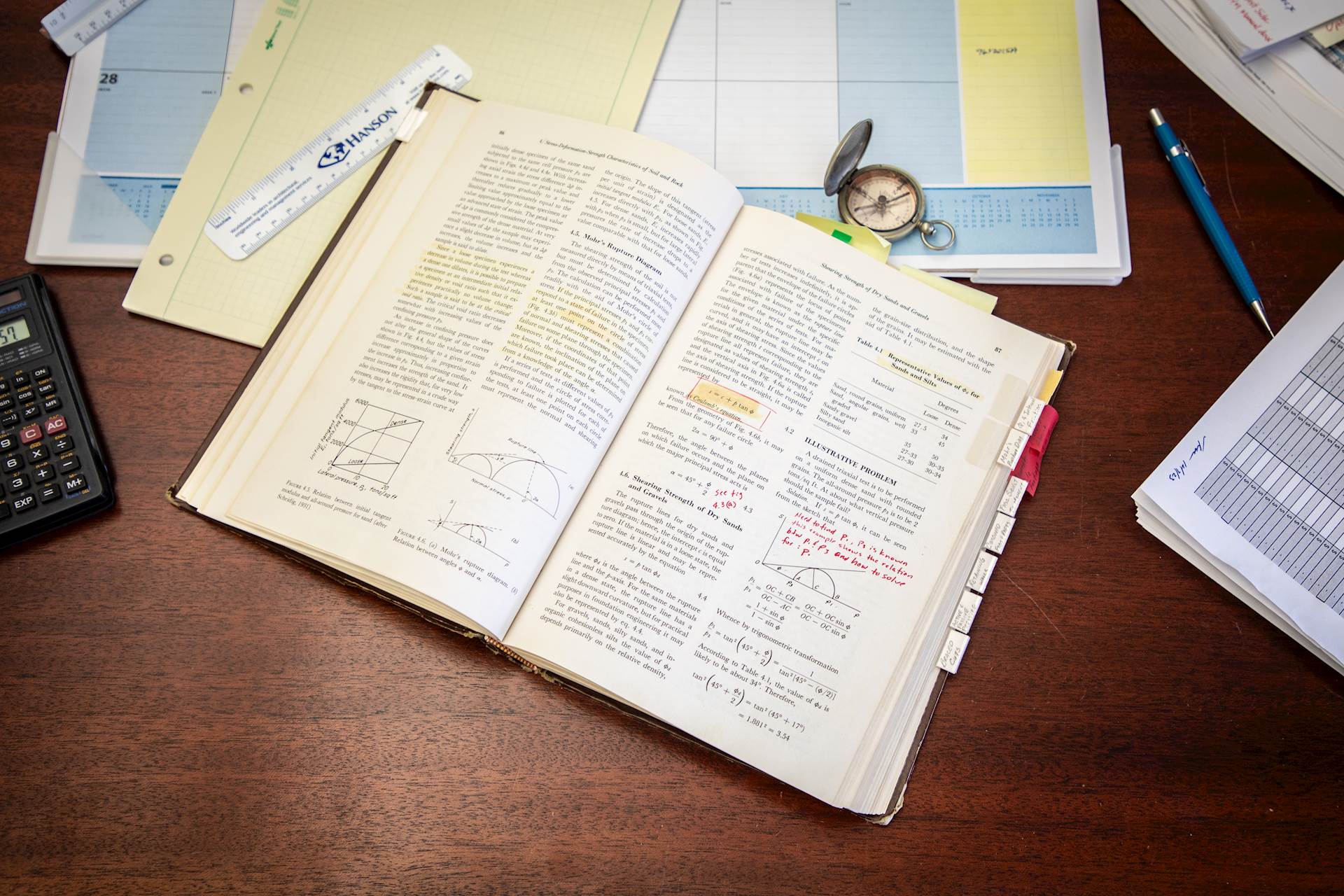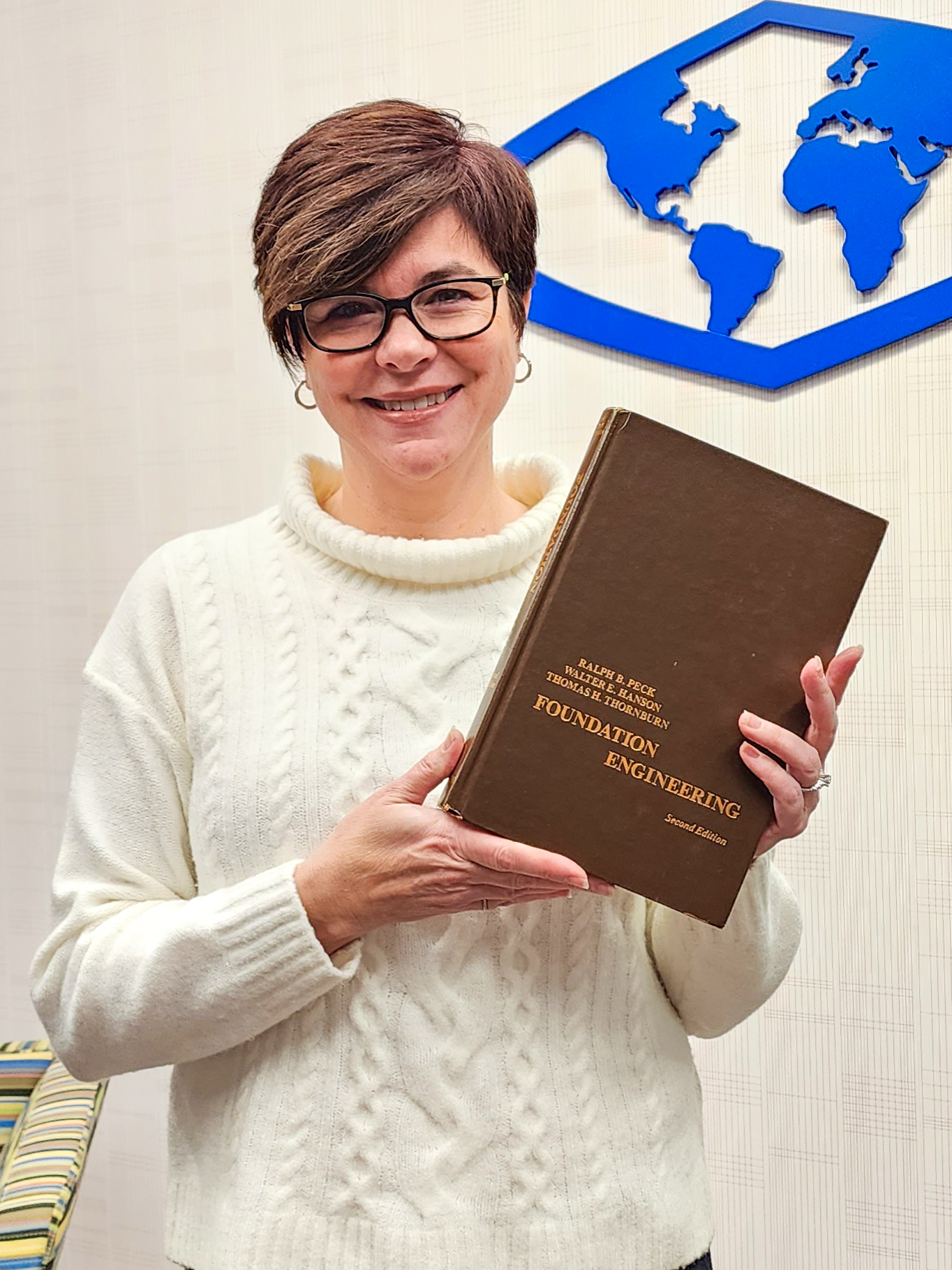
A 410-page college textbook first published in January 1953 and re-released about 20 years later as an expanded second edition has left a notable footprint — not only in engineering classrooms, but on office desks and bookshelves.
“Foundation Engineering,” by Ralph Peck, Hanson founder Walt Hanson and Thomas Thornburn, addresses topics including the properties of subsurface materials, foundation types and construction methods, foundation type selection and design basis, as well as the design of foundations and earth-retaining structures.
The textbook, whose second edition was published in 1974, has influenced more than one generation of engineers. According to an article on Copernicus Publications’ open-access journal “History of Geo- and Space Sciences,” the book’s first edition was “immediately adopted as a reference book in more than 50 universities.” Several Hanson engineers were among the students who learned from the book in college. Still others obtained and have used the book for reference since starting their careers.
“Walt Hanson’s role in the writing of ‘Foundation Engineering’ is a point of pride for our company and employee-owners,” Hanson’s Chairman and CEO Sergio “Satch” Pecori said of the book. “Just as it contributed to the education of many engineers decades ago, it continues to inform those who reference it today.”
‘Immediate success and acceptance’
Don Oglesby, a senior vice president at Hanson, started working at the firm in 1955, seven months after the company was founded in Springfield, Illinois. He used the first edition of “Foundation Engineering” when he was a student in an undergraduate course at the University of Illinois Urbana-Champaign (UIUC).
“When I took the undergraduate courses in foundation engineering at UIUC in the early 1960s, the courses were named soil properties, soil mechanics and foundation engineering, because the current term, ‘geotechnical engineering,’ had not yet been coined,” Don said.
“The courses I took used the 1959 sixth printing of the 1953 first edition of Walt’s book as the required reading. That this was the sixth printing in as many years speaks to the immediate success and acceptance of the book at that time. Both the first edition and second (1974) edition were used extensively by me and other Hanson engineers who worked in the ’60s and ’70s on Hanson’s first major geotechnical project — foundation investigations and designs for AT&T’s microwave tower and building sites and underground coaxial transmission facilities connecting the entire U.S.
“Over the years, I and others have provided autographed copies of the second edition to many Hanson clients, who greatly appreciated the favor (both my first and second editions are autographed). In later years, Walt and Dr. Peck started work on a third edition with the support of two UIUC professors, but Dr. Peck’s passing in 2008 ended the effort. The second edition continues to be cited as a reference in the more current books and publications on geotechnical engineering.”
Hanson’s geostructural practice provides geotechnical and structural engineering, which were the first services Hanson offered upon its founding in 1954, according to “From a Kansas Farm to the Engineering Hall of Fame: The Legacy of Walter E. Hanson, P.E., S.E., Hon. M. ASCE.” Walt, along with his “Foundation Engineering” co-authors and fellow UIUC professors, wrote the well-known textbook based on course materials they had established at UIUC. The book’s second edition, to which Walt contributed, was released in 1974, translated into Spanish, Russian and Indonesian and used internationally. The late Rod Huffman, who retired as a senior technician in 2017 after serving Hanson for 50 years, drafted the design plates in the second edition.
‘A solid reference’
Within a couple weeks of starting with Hanson as a senior vice president and senior market adviser Oct. 2, 2023,
 Shelby Swango, P.E., with her copy of "Foundation Engineering."
Shelby Swango, P.E., with her copy of "Foundation Engineering."
Shelby Swango, P.E., was surprised and excited to find that her copy of “Foundation Engineering,” which she had used as a student while pursuing her bachelor’s and master’s degrees at Purdue University in West Lafayette, Indiana, was co-authored by Walt.
“It was one of the first books I got in college,” Shelby, who works at the Indianapolis office, said. “It was a solid reference throughout my formative years of engineering.”
Shelby graduated with a focus in bridge engineering, but the recession that was occurring when she entered the workforce meant there wasn’t much bridge work available. She found herself designing other structures, such as retaining walls, and she said the book was a great reference for that type of engineering.
Walt wasn’t known as well at Purdue as he was at UIUC, where he served as a professor, so Shelby didn’t immediately realize she was at the firm founded by one of the textbook’s authors when she became a Hanson employee. “With it being years after college, the connection didn’t occur to me at all,” she said, until she had a conversation with one of her new co-workers about Walt’s connection to the book.
“I jumped right up and went to my bookshelf to grab it,” she recalled.
Although Shelby’s career has evolved away from daily engineering practice, she has found that the book still occasionally serves as a place to find answers and refresh her knowledge of foundation design principles. She recalled when she used it as a resource after reviewing a set of plans with a foundation that appeared over-designed; the book helped her verify that a more efficient design was possible. Another time, she consulted the book while providing advice to a friend who wasn’t confident in her contractor’s recommendations about a retaining wall project.
‘Why I work at Hanson’
“That book is why I work at Hanson,” said Senior Vice President and Power Market Principal Dan Whalen, P.E., who works at the Springfield office. He recalled that, during his early days with the company, Peck would come to Springfield to visit Walt, and he would go to breakfast or lunch with them. His copy of “Foundation Engineering” contains signatures by Walt and Ralph.
Several other Hanson employees own copies of the book, either from college or obtained during their careers.
David McDonald, P.E., PTOE, Ph.D., a vice president and Hanson’s roadway discipline manager and chief roadway engineer who works at the Chicago regional office, said he didn’t use “Foundation Engineering” while earning his bachelor’s and master’s degrees at Clemson University and his Ph.D. at Vanderbilt University; however, “I bought it about four years after I graduated to help me study for my P.E. exam. It still has my Post-it notes from when I marked pages for the exam.”
“I was not introduced to the book until I worked here,” said Senior Geotechnical Engineer Jim Knutelski, P.E., G.E., in Springfield, “but I keep a copy on my desk at arm’s reach — it’s one of my go-to references.”
Vice President and Chief Project Management Officer Mike Flatt, P.E., S.E., PMP, LEED AP®, not only used “Foundation Engineering” in his geotechnical engineering class at UIUC, but he also conducted an independent study with Walt to update the design plates for the book’s planned third edition, which Walt worked on for the remainder of his life but was unable to complete before his passing. “Mr. Hanson and I drove from Springfield to the university many times together,” Mike, who also is in Springfield, said. “He was debating the use of load and resistance factor design in soil mechanics with the professors at UIUC, which made for some interesting conversations.”